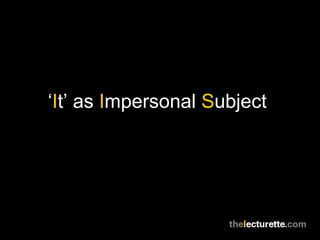'It' as Impersonal Subject
•Download as PPT, PDF•
5 likes•10,029 views
Using 'It' as an impersonal subject. For more English tutorials, please visit: https://www.thelecturette.com
Report
Share
Report
Share

Recommended
More Related Content
Viewers also liked
Viewers also liked (20)
Meetings: Communicating towards a Successful Outcome

Meetings: Communicating towards a Successful Outcome
Similar to 'It' as Impersonal Subject
Similar to 'It' as Impersonal Subject (20)
More from theLecturette
More from theLecturette (20)
6 Effective Stepts towards Improving You Speaking Skills

6 Effective Stepts towards Improving You Speaking Skills
Recently uploaded
https://app.box.com/s/7hlvjxjalkrik7fb082xx3jk7xd7liz3TỔNG ÔN TẬP THI VÀO LỚP 10 MÔN TIẾNG ANH NĂM HỌC 2023 - 2024 CÓ ĐÁP ÁN (NGỮ Â...

TỔNG ÔN TẬP THI VÀO LỚP 10 MÔN TIẾNG ANH NĂM HỌC 2023 - 2024 CÓ ĐÁP ÁN (NGỮ Â...Nguyen Thanh Tu Collection
https://app.box.com/s/x7vf0j7xaxl2hlczxm3ny497y4yto33i80 ĐỀ THI THỬ TUYỂN SINH TIẾNG ANH VÀO 10 SỞ GD – ĐT THÀNH PHỐ HỒ CHÍ MINH NĂ...

80 ĐỀ THI THỬ TUYỂN SINH TIẾNG ANH VÀO 10 SỞ GD – ĐT THÀNH PHỐ HỒ CHÍ MINH NĂ...Nguyen Thanh Tu Collection
Recently uploaded (20)
Interdisciplinary_Insights_Data_Collection_Methods.pptx

Interdisciplinary_Insights_Data_Collection_Methods.pptx
dusjagr & nano talk on open tools for agriculture research and learning

dusjagr & nano talk on open tools for agriculture research and learning
Simple, Complex, and Compound Sentences Exercises.pdf

Simple, Complex, and Compound Sentences Exercises.pdf
Python Notes for mca i year students osmania university.docx

Python Notes for mca i year students osmania university.docx
Food safety_Challenges food safety laboratories_.pdf

Food safety_Challenges food safety laboratories_.pdf
21st_Century_Skills_Framework_Final_Presentation_2.pptx

21st_Century_Skills_Framework_Final_Presentation_2.pptx
TỔNG ÔN TẬP THI VÀO LỚP 10 MÔN TIẾNG ANH NĂM HỌC 2023 - 2024 CÓ ĐÁP ÁN (NGỮ Â...

TỔNG ÔN TẬP THI VÀO LỚP 10 MÔN TIẾNG ANH NĂM HỌC 2023 - 2024 CÓ ĐÁP ÁN (NGỮ Â...
Beyond_Borders_Understanding_Anime_and_Manga_Fandom_A_Comprehensive_Audience_...

Beyond_Borders_Understanding_Anime_and_Manga_Fandom_A_Comprehensive_Audience_...
NO1 Top Black Magic Specialist In Lahore Black magic In Pakistan Kala Ilam Ex...

NO1 Top Black Magic Specialist In Lahore Black magic In Pakistan Kala Ilam Ex...
80 ĐỀ THI THỬ TUYỂN SINH TIẾNG ANH VÀO 10 SỞ GD – ĐT THÀNH PHỐ HỒ CHÍ MINH NĂ...

80 ĐỀ THI THỬ TUYỂN SINH TIẾNG ANH VÀO 10 SỞ GD – ĐT THÀNH PHỐ HỒ CHÍ MINH NĂ...
'It' as Impersonal Subject
- 1. ‘It’ as Impersonal Subject
- 2. ‘It’ as Impersonal Subject ‘It’ is a pronoun. As a personal pronoun it refers back to something that has already been mentioned. They learn to speak English before they learn to read it. Maybe he changed his mind, but I doubt it.
- 3. ‘It’ as Impersonal Subject You can also use ‘it’ as the subject of a sentence when it does not refer back to anything that has already been mentioned. This impersonal use of ‘it’ introduces new information, and is used particularly to talk about times, dates, the weather, and personal opinions.
- 4. ‘It’ as Impersonal Subject You use impersonal ‘it’ with a form of ‘be’ to talk about the time or the date. It is nearly one o’ clock. It’ s the sixth of April today.
- 5. ‘It’ as Impersonal Subject You use impersonal ‘it’ with verbs that refer to the weather: drizzle pour sleet thunder hail rain snow
- 6. ‘It’ as Impersonal Subject It’ s still raining. It snowed steadily through the night. It was pouring with rain.
- 7. ‘It’ as Impersonal Subject You can describe the weather by using ‘it’ followed by ‘be’ and an adjective with or without a noun. It’ s a lovely day. It was very bright.
- 8. ‘It’ as Impersonal Subject You can describe a change in the weather by using ‘it’ followed by ‘get’ and an adjective. It was getting cold. It’ s getting dark.
- 9. ‘It’ as Impersonal Subject You use impersonal ‘it’, followed by a form of ‘be’ and an adjective or a noun group, to express your opinion about a place, a situation, or an event. The adjective or noun group can be followed by an adverbial or by an ‘-ing’ clause, a ‘to’-infinitive clause, or a ‘that’-clause.
- 10. ‘It’ as Impersonal Subject It was terribly cold in the rooms. It’ s fun working for him. It was a pleasure to be there. It’ s strange that it hasn’ t been noticed before.
- 11. ‘It’ as Impersonal Subject You use ‘it’ followed by a verb such as ‘interest’, ‘please’, ‘surprise’, or ‘upset’ which indicates someone’s reaction to a fact, situation or event. The verb is followed by a noun group, and a ‘that’-clause or a ‘to’- infinitive clause.
- 12. ‘It’ as Impersonal Subject It pleases me that he wants to talk about his work. It surprised him to realize that he hadn’ t thought avout them until now.
- 13. ‘It’ as Impersonal Subject You can also use ‘it’ with the passive of a reporting verb and a ‘that’-clause when you want to suggest that an opinion or belief is shared by many people. This use is particularly common in news reports, for example in newspapers, news websites, on the radio, or on television.
- 14. ‘It’ as Impersonal Subject It was said that he could speak their language. Nowadays it is believed that the size is unimportant. It is thought that about a million puppies are born each year.
- 15. ‘It’ as Impersonal Subject Note: The passive of reporting verbs can also be used without impersonal ‘it’ to express general opinions. The factories were said to be much worse. They are believed to be dangerous.
- 16. Questions? For more slide presentations visit:
